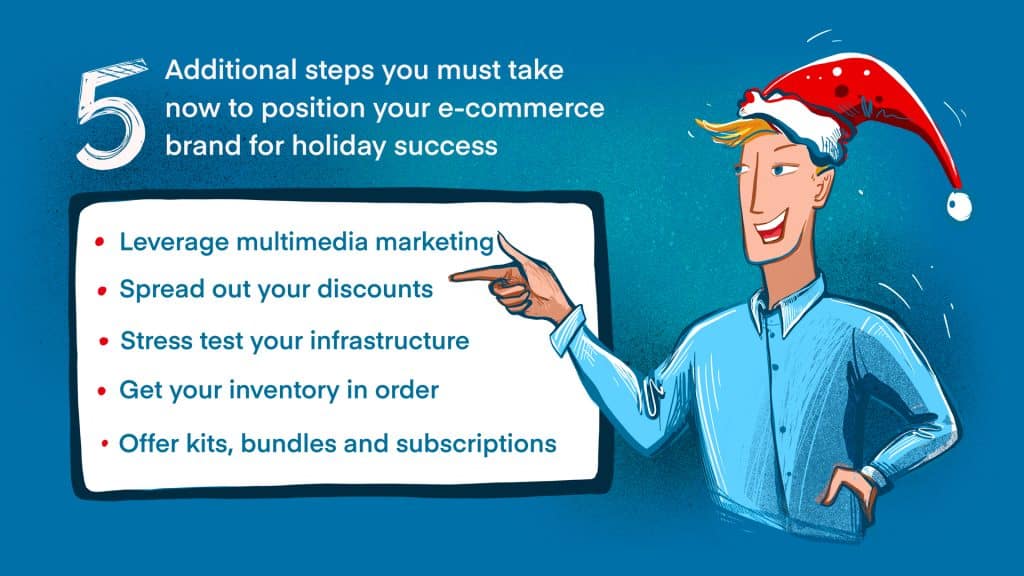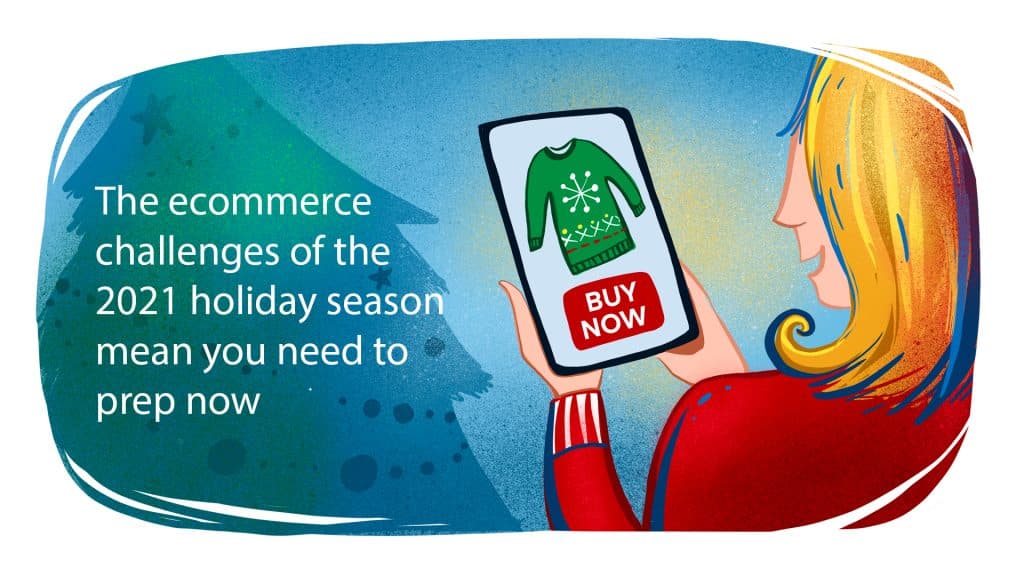
Experts are calling for another unprecedented holiday season for online sales. eMarketer predicts ecommerce will account for a whopping $206.88 billion of this year’s holiday retail sales—18.9% of a nearly $1.1 trillion pie.
If the projection holds, this would be an 11.3% increase over last year’s record-setting holiday e-commerce sales.
Last year, e-commerce took center stage, as many brick-and-mortar retailers faced shoppers who were reluctant to venture into stores.
Online sellers could reap the benefits, but success also meant having to contend with unique fulfillment challenges: online orders surged, but supply chains were stretched thin, and shipping carriers struggled to keep up.
While the evolution of the COVID-19 pandemic has changed as this holiday season approaches, many of our top ten tips for holiday e-commerce success from last year still apply.
Being proactive will be as crucial as ever when maximizing your selling potential.
That said, although some inevitable similarities will exist between this Q4 and last, you need to start taking steps now to prepare for the differences.
This Holiday Season Has Its Own Unique Challenges
As we remain in the throes of the COVID-19 pandemic, the 2021 holiday season still has plenty of unknowns.
However, there are some issues that every e-commerce seller will have to face in one way or another.
Brick-and-Mortar Is Back
While in-store shopping was an option last season, many avoided it altogether. This year, the availability of vaccines and the growing push to return to normalcy have brought shoppers back into the stores.
This increases the level of competition, as ecommerce brands once again must provide value and convenience that can outmatch customers’ growing local retail options.
According to a National League of Cities report, after a devastating 2020 that shuttered many small retail businesses and led to the closure of over 12,000 retail chain locations, there has been a nearly 40% year-over-year (YOY) increase in retail store openings in 2021.
Many of these retail locations will not only challenge your ecommerce business physically but also online.
Retailers continue to offer customers the opportunity to order online and pick up in-store (affectionately referred to as click-and-mortar by some).
Many customers grew more comfortable with this shopping style during the pandemic, ordering everything from groceries to cars online from local retailers out of necessity.
As the holiday shopping season approaches, expect customers to be more eager than ever to opt for click-and-mortar options as they seek out the convenience of online shopping without worrying about fulfillment delays or shipping issues interfering with their gift-giving.
To compete effectively, your omnichannel ecommerce retail business must be prepared to offer top-notch service and reliability.
Labor Is Expensive
The national labor shortage remains a major concern.
Even as job numbers continue to trend positively, key positions in the supply chain, logistics, and manufacturing industries remain unfilled.
Companies have to offer incentives and higher wages to try and staff up.
While this may be an issue you are facing now, it may also mean that Q4 seasonal staffing will prove challenging and expensive.
You must budget accordingly this holiday season, whether for your own staffing needs or the increased labor costs of those in your supply chain, logistics infrastructure, and/or customer service team.
Supply Chains Are Still a Mess
A shortage of warehouse workers, truckers, delivery personnel, and manufacturers also means the supply chains your business relies on are likely to struggle to keep up with holiday demand.
Depending on your merchandise and where it comes from, certain global shortages (like the ongoing semiconductor chip shortage or the shipping container crisis) may hinder your ability to get the inventory you need to meet holiday demand.
If these challenges negatively impact your business, stocking up now for Q4 may be more cost-effective than placing expensive rush orders or running out of stock when the holiday orders start pouring in.
Inflation Means Costs and Prices Are Rising
The Consumer Price Index (CPI) continues to grow month-over-month, and while the latest inflation reports seem to be in line with economists’ projections, increased supply chain and fulfillment expenses will almost certainly be passed on to customers as they start their holiday shopping.
Don’t be afraid to optimize your listing prices to account for increases in overhead.
Competition Will Be Fierce
Even though e-commerce’s share of holiday 2021 spending will likely be larger than ever, the industry has more players than ever.
To be ready to compete, start optimizing your marketing strategies, catalog listings, and website performance now.

5 Additional Steps You Must Take Now to Position Your E-Commerce Brand for Holiday Success
While our advice for preparing for holiday 2020 still rings true today, several additional tips can help you get the most out of holiday 2021:
1. Be Prepared to Leverage Multimedia Marketing
To stand out, you must include diverse multimedia in your listings and marketing efforts.
Use both video and optimized images tailored to your audience as a way of bringing your products to life.
As you plan marketing strategies and listing revisions to target holiday sales, include relevant visual media whenever possible.
2. Spread Out Your Discounts
With fulfillment looming as a potential bottleneck for holiday sales, you may want to reconsider your strategies for offering sales and discounts on your products.
Rather than hyper-focusing on Black Friday, Cyber Monday, or other short-term sales windows, spread out your discounts throughout the holiday season.
You won’t be alone. Extended holiday sales windows were a growing retail trend even before the pandemic.
Jumping on board with this practice should help you maintain inventory (and avoid costly overselling) and not overburden a potentially short-staffed fulfillment team.
3. Stress Test Your Infrastructure Sooner than Later
Be sure your website, warehouse, and staff are tuned up and ready for the holidays well before they arrive.
Investing in easily scalable software and technology now can eliminate the headaches of scaling a piecemeal collection of tools and interfaces amid an onrush of orders.
4. Get Your Inventory in Order, Know What You Have and Where You Have It
You don’t want to be caught flat-footed this holiday season with too little merchandise or merchandise stored in the wrong places.
Reliable cycle counting workflows—like those supported by Skustack—can help you establish a reliable tally of your stock levels now and maintain that accuracy and dependability when business picks up.
Furthermore, you need a proper inventory management system that allows you to initiate and track warehouse-to-warehouse stock transfers.
One key to reducing fulfillment times (and keeping customers happy) is having merchandise close to where orders originate.
Whether this means maintaining bi-coastal warehouses or enlisting the help of geographically diverse 3PL partners, Skutack and Sellercloud can help you get the products you need closer to where your customers are.
5. Consider Offering Kits, Bundles, and Subscriptions This Holiday Season
Combining related and/or complimentary items into bundled SKUs can be a unique way to add value to your e-commerce catalog and additional purchasing options for your customers.
Skustack allows you to create, customize, and fulfill these kitted orders across your omnichannel listings without creating headaches for your inventory tracking or fulfillment teams.
Similarly, subscription offerings are particularly useful if you are concerned with carrying too much unsold inventory into Q1 2022.
By offering customers what essentially boils down to a recurring order of a product or series of themed merchandise, you can create a gift that keeps giving for your customers and your bottom line.
Subscriptions can provide a way to consistently move inventory and generate revenue even after the holidays.
Skustack and the entire family of Sellercloud products can provide the tools and organization you need to manage your omnichannel ecommerce from a single, convenient interface—through the holidays and beyond.
Contact us directly for a free demo today and put your e-commerce brand in a position to make this Q4 your best.




